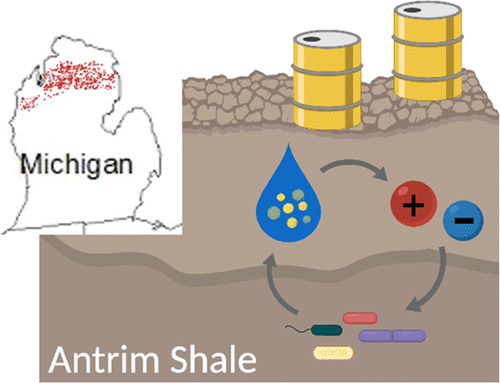当前位置:
X-MOL 学术
›
ACS Earth Space Chem.
›
论文详情
Our official English website, www.x-mol.net, welcomes your
feedback! (Note: you will need to create a separate account there.)
Biogeochemistry of the Antrim Shale Natural Gas Reservoir
ACS Earth and Space Chemistry ( IF 2.9 ) Pub Date : 2021-06-16 , DOI: 10.1021/acsearthspacechem.1c00087 Brooke Stemple 1, 2 , Kara Tinker 3, 4 , Preom Sarkar 2, 3 , Josh Miller 2, 3 , Djuna Gulliver 3 , Kyle Bibby 1, 2
ACS Earth and Space Chemistry ( IF 2.9 ) Pub Date : 2021-06-16 , DOI: 10.1021/acsearthspacechem.1c00087 Brooke Stemple 1, 2 , Kara Tinker 3, 4 , Preom Sarkar 2, 3 , Josh Miller 2, 3 , Djuna Gulliver 3 , Kyle Bibby 1, 2
Affiliation

|
The Antrim Shale, located in the Michigan Basin, United States (U.S.), is a major U.S. shale play having produced over 2.5 Trillion Cubic Feet (Tcf) of unconventional shale natural gas as of 2010. The shallow nature of this formation sets it apart from other, more characterized unconventional shale gas plays. The depth of gas production of the Antrim ranges from approximately 150 to 600 m and it is typically vertically drilled, contrary to deeper, horizontally drilled shales. A thorough understanding of the biogeochemistry and microbiology of this complex system will be advantageous for improving well performance, produced water management, and potential biocidal treatment as microbial community composition can vary substantially even among closely spaced wells. In this study, we analyzed produced water collected from nine different wells in the Antrim Shale by investigating the geochemical and microbial community composition of the produced water to gain greater insight into the overall biogeochemistry of this unique shale system. The majority of the wells from this study had high total dissolved solids (TDS) primarily composed of chloride and sodium, averaging 86 804 mg/L with a maximum 116 223 mg/L; however, three of the wells sampled along the northern margin of the basin exhibited significantly lower TDS ranging from 4932 to 6496 mg/L. Our microbial community analysis revealed relatively low abundance within our samples and high variability of the microbial community among the sampled wells. The majority of bacterial sequences were identified within Proteobacteria, Firmicutes, and Actinobacteria phyla and metagenomic sequencing revealed the low presence of Methanobacteriaceae within each sample. We also investigated potential microbial community drivers and found that TDS, sodium, chloride, iodide, bromide, ammonium, potassium, and strontium were significantly correlated with the observed microbial community. The varying geochemical conditions between wells demonstrate different subsurface environmental niches, potentially driving the heterogeneous microbial communities we observed from well to well. This analysis suggests an important relationship between both well location and geochemistry and the observed microbial community that can persist in the reservoir. Continued studies of the Antrim Shale will improve our understanding of the complex interdependencies of this ecosystem.
中文翻译:

安特里姆页岩气藏生物地球化学
位于美国密歇根盆地的安特里姆页岩是美国主要的页岩油田,截至 2010 年已生产了超过 2.5 万亿立方英尺 (Tcf) 的非常规页岩天然气。该地层的浅层性质使其与众不同来自其他更具特色的非常规页岩气田。Antrim 的天然气生产深度范围约为 150 至 600 m,与更深的水平钻探页岩相反,它通常是垂直钻探的。彻底了解这个复杂系统的生物地球化学和微生物学将有利于提高井性能、采出水管理和潜在的杀菌处理,因为即使在间隔很近的井中,微生物群落组成也可能有很大差异。在这项研究中,我们通过调查采出水的地球化学和微生物群落组成,分析了从安特里姆页岩中 9 口不同井收集的采出水,以更深入地了解这一独特页岩系统的整体生物地球化学。本研究中的大多数井具有较高的总溶解固体 (TDS),主要由氯化物和钠组成,平均为 86 804 毫克/升,最大为 116 223 毫克/升;然而,沿盆地北缘采样的三口井的 TDS 显着较低,范围为 4932 至 6496 毫克/升。我们的微生物群落分析显示,我们的样本中的丰度相对较低,并且采样井中微生物群落的变异性较高。大多数细菌序列在 本研究中的大多数井具有较高的总溶解固体 (TDS),主要由氯化物和钠组成,平均为 86 804 毫克/升,最大为 116 223 毫克/升;然而,沿盆地北缘采样的三口井的 TDS 显着较低,范围为 4932 至 6496 毫克/升。我们的微生物群落分析显示,我们的样本中的丰度相对较低,并且采样井中微生物群落的变异性较高。大多数细菌序列在 本研究中的大多数井具有较高的总溶解固体 (TDS),主要由氯化物和钠组成,平均为 86 804 毫克/升,最大为 116 223 毫克/升;然而,沿盆地北缘采样的三口井的 TDS 显着较低,范围为 4932 至 6496 毫克/升。我们的微生物群落分析显示,我们的样本中的丰度相对较低,并且采样井中微生物群落的变异性较高。大多数细菌序列在 我们的微生物群落分析显示,我们的样本中的丰度相对较低,并且采样井中微生物群落的变异性较高。大多数细菌序列在 我们的微生物群落分析显示,我们的样本中的丰度相对较低,并且采样井中微生物群落的变异性较高。大多数细菌序列在变形杆菌、厚壁菌门和放线菌门和宏基因组测序显示甲烷杆菌科的含量很低在每个样本中。我们还调查了潜在的微生物群落驱动因素,发现 TDS、钠、氯、碘、溴、铵、钾和锶与观察到的微生物群落显着相关。井之间不同的地球化学条件表明了不同的地下环境生态位,这可能会推动我们从一口井到另一口井观察到的异质微生物群落。该分析表明,井位和地球化学与观察到的可在储层中持续存在的微生物群落之间存在重要关系。对安特里姆页岩的持续研究将增进我们对这个生态系统复杂的相互依存关系的理解。
更新日期:2021-07-15
中文翻译:

安特里姆页岩气藏生物地球化学
位于美国密歇根盆地的安特里姆页岩是美国主要的页岩油田,截至 2010 年已生产了超过 2.5 万亿立方英尺 (Tcf) 的非常规页岩天然气。该地层的浅层性质使其与众不同来自其他更具特色的非常规页岩气田。Antrim 的天然气生产深度范围约为 150 至 600 m,与更深的水平钻探页岩相反,它通常是垂直钻探的。彻底了解这个复杂系统的生物地球化学和微生物学将有利于提高井性能、采出水管理和潜在的杀菌处理,因为即使在间隔很近的井中,微生物群落组成也可能有很大差异。在这项研究中,我们通过调查采出水的地球化学和微生物群落组成,分析了从安特里姆页岩中 9 口不同井收集的采出水,以更深入地了解这一独特页岩系统的整体生物地球化学。本研究中的大多数井具有较高的总溶解固体 (TDS),主要由氯化物和钠组成,平均为 86 804 毫克/升,最大为 116 223 毫克/升;然而,沿盆地北缘采样的三口井的 TDS 显着较低,范围为 4932 至 6496 毫克/升。我们的微生物群落分析显示,我们的样本中的丰度相对较低,并且采样井中微生物群落的变异性较高。大多数细菌序列在 本研究中的大多数井具有较高的总溶解固体 (TDS),主要由氯化物和钠组成,平均为 86 804 毫克/升,最大为 116 223 毫克/升;然而,沿盆地北缘采样的三口井的 TDS 显着较低,范围为 4932 至 6496 毫克/升。我们的微生物群落分析显示,我们的样本中的丰度相对较低,并且采样井中微生物群落的变异性较高。大多数细菌序列在 本研究中的大多数井具有较高的总溶解固体 (TDS),主要由氯化物和钠组成,平均为 86 804 毫克/升,最大为 116 223 毫克/升;然而,沿盆地北缘采样的三口井的 TDS 显着较低,范围为 4932 至 6496 毫克/升。我们的微生物群落分析显示,我们的样本中的丰度相对较低,并且采样井中微生物群落的变异性较高。大多数细菌序列在 我们的微生物群落分析显示,我们的样本中的丰度相对较低,并且采样井中微生物群落的变异性较高。大多数细菌序列在 我们的微生物群落分析显示,我们的样本中的丰度相对较低,并且采样井中微生物群落的变异性较高。大多数细菌序列在变形杆菌、厚壁菌门和放线菌门和宏基因组测序显示甲烷杆菌科的含量很低在每个样本中。我们还调查了潜在的微生物群落驱动因素,发现 TDS、钠、氯、碘、溴、铵、钾和锶与观察到的微生物群落显着相关。井之间不同的地球化学条件表明了不同的地下环境生态位,这可能会推动我们从一口井到另一口井观察到的异质微生物群落。该分析表明,井位和地球化学与观察到的可在储层中持续存在的微生物群落之间存在重要关系。对安特里姆页岩的持续研究将增进我们对这个生态系统复杂的相互依存关系的理解。











































 京公网安备 11010802027423号
京公网安备 11010802027423号